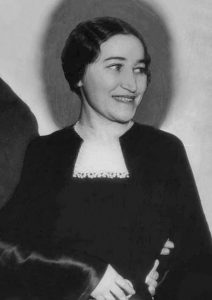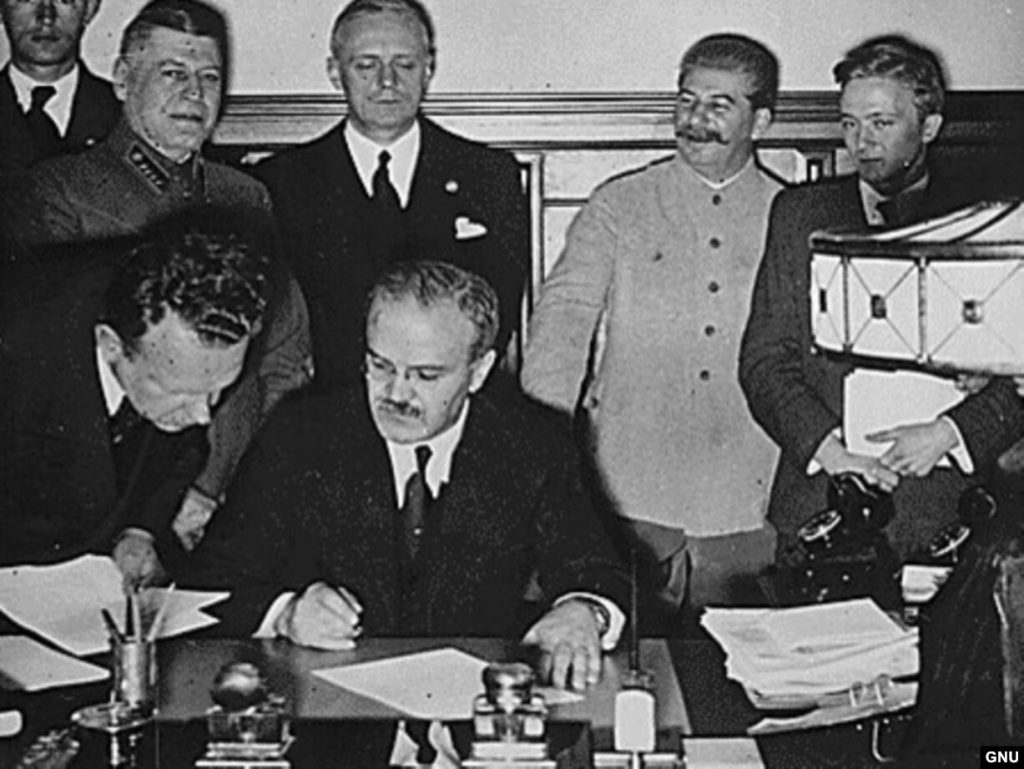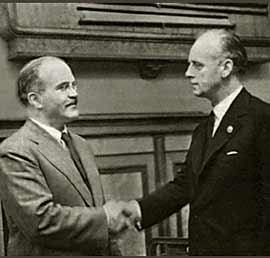Posted 30/1/2024
Polina, Molotov’s Jewish Wife
Robert Liebman
 Hitler needed it, to pave the way for his powerful Wehrmacht to attack Poland. Stalin needed it, to buy time to bulk up his Red Army.* On 23 August 1939, their foreign secretaries delivered it: the non-aggression Ribbentrop-Molotov Pact.
Hitler needed it, to pave the way for his powerful Wehrmacht to attack Poland. Stalin needed it, to buy time to bulk up his Red Army.* On 23 August 1939, their foreign secretaries delivered it: the non-aggression Ribbentrop-Molotov Pact.
Bitter enemies—Communist Soviet Union and Fascist Germany—instantly became allies.
A week later, on 1 September, Germany invaded Poland. The Second World War in Europe had begun.
The complex agreement, with its secret land-grabbing protocol, was composed, signed, sealed and delivered in a matter of days.
The mood was celebratory, both in Moscow, where the negotiations and signing ceremony took place, and in Berlin.

Molotov signs, Stalin smiles.
Hitler was happy. Stalin was happy. Vyacheslav Molotov, Stalin’s dour, loyal foreign minister, delivered what his boss demanded. He was happy. His wife was another story.
Polina Semyonovna Zhemchuzhina was Jewish. She was a secular atheist in an officially atheistic nation who nevertheless retained a strong if mostly submerged Jewish identity. And when, years later, she revealed the true depth of her identity as a Jew, she got into trouble, potentially lethal, trouble, with the man who had partnered with Hitler.
Polina Semyonovna Zhemchuzhina (1897-1970) is the Russified name she chose herself. She was born Perl Solomonovna Karpovskaya; her middle name is an ethnic give-away. And in selecting her new Russian name, she deliberately maintained ties with her birth name: “Polina” means “little stone,” and Zhemchuzhina means “pearl.”
Polina raised two daughters while also holding prominent ministerial positions in cosmetics before moving on to fisheries and textiles.
A party hosted by Stalin and his wife Nadezhda Alliluyeva might have had profound consequences for Polina many years later. During the shindig, Stalin criticised his wife. Later that evening, she killed herself.
Polina had no connection with Nadezhda’s suicide, but the women had been close friends. That was all that Stalin’s suspicious nature needed. He did nothing at the time, thereby sparing Polina a prison sentence or worse, but she became a marked woman. The stain was indelible.

Molotov was 96 when he died in a Moscow hospital; Ribbentrop was hanged in Nuremberg, age 53.
Between 1941 and 1945, Stalin was busy with other matters. A few years after the end of the Second World War, the dictator, a deft hand at purges, began a new, murderous reign of terror, largely focussed on the Jews.
In January 1948, Jewish actor-director Solomon Mikhoels, head of the Moscow State Jewish Theatre and chair of the Jewish Anti-Fascist Committee, had a fatal “accident.” Persecution of other prominent Jews swiftly followed.
The Slansky trial, which made international headlines in 1952, took its name from Czech communist leader Rudolf Slansky who, with 13 other defendants, was found guilty on trumped up charges. Eleven were executed and three were imprisoned for life. The charge against the Jews: they were Zionists.
A year later, nine doctors, mostly Jews, including Stalin’s own personal physician, were charged with murder and sedition. As was customary in such cases, they confessed (torture was also customary) and awaited sentencing. The death penalty was also the custom.
Another Party, Another Problem
Israel’s first ambassador to the Soviet Union, after its founding in 1948, was Golda Meir (nee Mabovitch and, by marriage, Meyerson, and later still, by choice, Meir).
Born in Kiev in 1989, Meir was raised in the American state of Wisconsin before emigrating to Palestine in 1921. Her Russian was iffy but she spoke English, Hebrew and Yiddish.
When Soviet Foreign Minister Molotov hosted a reception in her honour as the new ambassador, Polina and Golda met and sought a common language. They found one.
In Russian, through her interpreter, Polina said “I don’t speak Hebrew, of course, but I speak Yiddish—do you speak Yiddish?”
“Well, that was the shock of my life,” Meir later explained. “I turned directly to her in astonishment and said, ‘How do you speak Yiddish?’ ‘Why,’she said, ‘I’m a daughter of Israel’—that’s how she put it—“A Jewess.” Immediately we had a common language.”
Polina also spoke with Meir’s daughter Sarah, telling her to “Be well. If everything goes well with you, it will go well for all Jews everywhere.”
It was all Greek to Stalin who, while he could not understand what was being said, did not like what he saw. The loyalty of every Soviet citizen should go to him and their country. Zionism was a threat, Polina personified it, and this time, instead of ignoring her seditious attitudes and behaviour, he acted.
She was charged with treason, arrested, duly found guilty and forced to divorce her husband. Then she disappeared.
For all that her deeply distraught husband knew, she had been murdered. He learned that she was alive only because Stalin’s henchman Laventiy Beria, head of the NKVD, told him that she had been exiled to Siberia.
Stalin died (5 March 1953) in the nick of time for Polina, who was promptly released from prison. Told that Stalin had died only a few days earlier, she fainted. She remarried Molotov.
Stalin’s death had even greater consequences for the physicians implicated in the Doctor’s Plot. The case against them was quickly exposed as a sham and they were released. If Stalin had been made of genetically sturdier stuff, they most likely would have been executed.
No Angel
Stalin biographer Simon Sebag Montefiore portrays Polina sympathetically but also objectively. While in prison, Polina received considerable support from other prisoners, especially the wealthy peasants known as kulaks.
“Ironically, she was befriended by some deported kulaks so that the innocent peasants, whom she and her husband had been so keen to liquidate, were the kind strangers who saved her life,” Montefiore writes. Both Molotovs died of natural causes, Polina at 73 and Vyacheslav at 96.
The cynical hastily-drafted Ribbentrop-Molotov Pact, aligning Communist-hating Nazis with Nazi-hating Communists, also had a sharply curtailed life span. On 22 June 1941, Germany invaded the Soviet Union. Despite ample (and then some) warnings, Stalin was caught by surprise. And his Red Army, despite a respite of nearly two full years, was still not ready.
* Take your pick:
Stalin “was even less ready for war than was the West. Concerned to postpone war rather than to provoke it, he was now anxious only to conciliate Hitler. Raison d’etat overruled hostility on both sides. On 23 August 1939 the German and Soviet governments announced the conclusioin of a non-aggression pact.” Michael Howard, The Oxford History of the Twentieth Century (1998), p.111.
“Just before the collapse of the USSR in 1991, Soviet historians exploded the myth that Stalin entered the Pact in order to gain time for strengthening the Red Army’s defences: the Red Army never adopted systematic defensive positions, even in 1941. …It may also be in the realm of possibility, as one ex-Soviet officer has suggested, that Stalin was biding his time, to launch a European offensive of his own.” Norman Davies, The Oxford Companion to the Second World War (1995), p.781.
###
